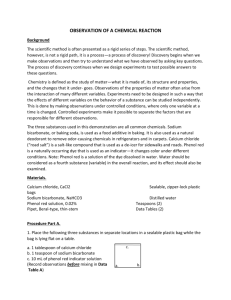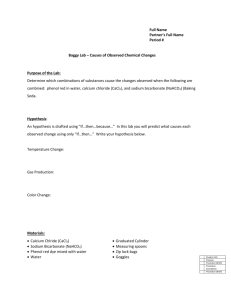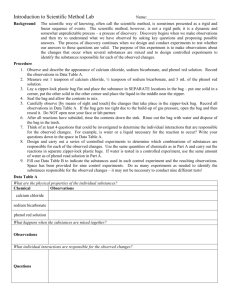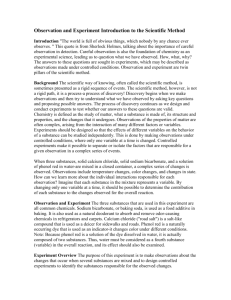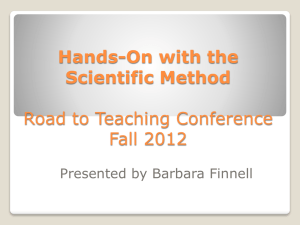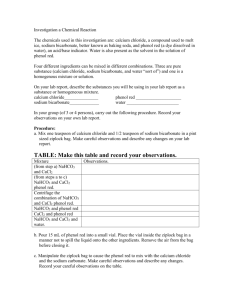Chemical Energy Lab
advertisement
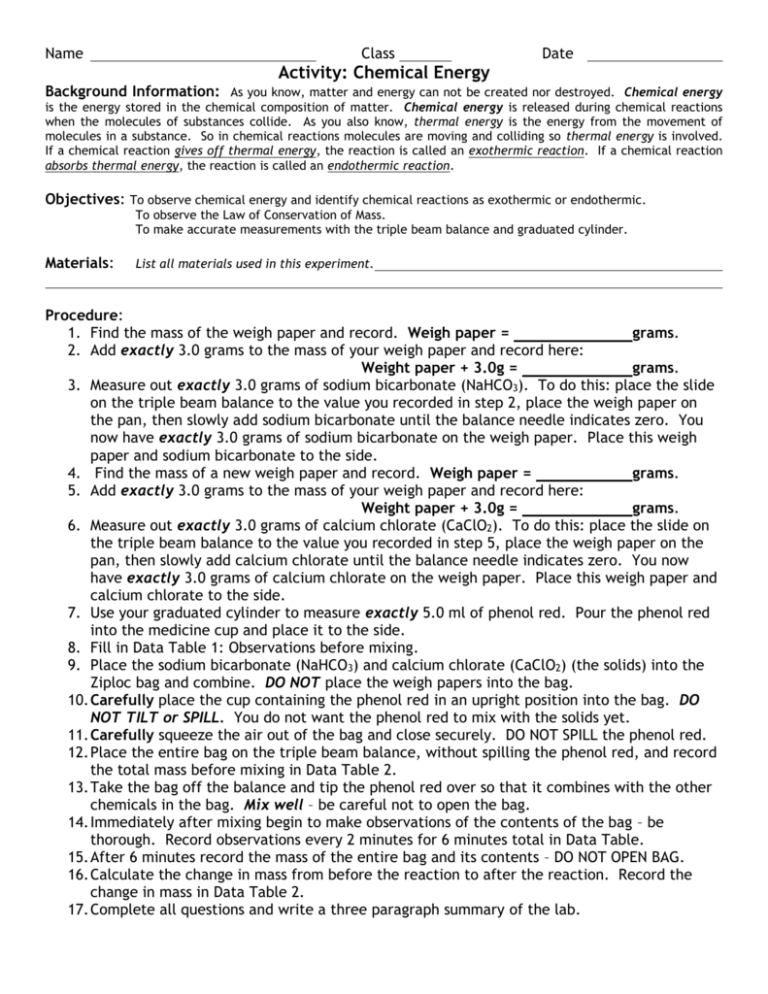
Name Class Date Activity: Chemical Energy Background Information: As you know, matter and energy can not be created nor destroyed. Chemical energy is the energy stored in the chemical composition of matter. Chemical energy is released during chemical reactions when the molecules of substances collide. As you also know, thermal energy is the energy from the movement of molecules in a substance. So in chemical reactions molecules are moving and colliding so thermal energy is involved. If a chemical reaction gives off thermal energy, the reaction is called an exothermic reaction. If a chemical reaction absorbs thermal energy, the reaction is called an endothermic reaction. Objectives: To observe chemical energy and identify chemical reactions as exothermic or endothermic. To observe the Law of Conservation of Mass. To make accurate measurements with the triple beam balance and graduated cylinder. Materials: List all materials used in this experiment. Procedure: 1. Find the mass of the weigh paper and record. Weigh paper = grams. 2. Add exactly 3.0 grams to the mass of your weigh paper and record here: Weight paper + 3.0g = grams. 3. Measure out exactly 3.0 grams of sodium bicarbonate (NaHCO3). To do this: place the slide on the triple beam balance to the value you recorded in step 2, place the weigh paper on the pan, then slowly add sodium bicarbonate until the balance needle indicates zero. You now have exactly 3.0 grams of sodium bicarbonate on the weigh paper. Place this weigh paper and sodium bicarbonate to the side. 4. Find the mass of a new weigh paper and record. Weigh paper = grams. 5. Add exactly 3.0 grams to the mass of your weigh paper and record here: Weight paper + 3.0g = grams. 6. Measure out exactly 3.0 grams of calcium chlorate (CaClO2). To do this: place the slide on the triple beam balance to the value you recorded in step 5, place the weigh paper on the pan, then slowly add calcium chlorate until the balance needle indicates zero. You now have exactly 3.0 grams of calcium chlorate on the weigh paper. Place this weigh paper and calcium chlorate to the side. 7. Use your graduated cylinder to measure exactly 5.0 ml of phenol red. Pour the phenol red into the medicine cup and place it to the side. 8. Fill in Data Table 1: Observations before mixing. 9. Place the sodium bicarbonate (NaHCO3) and calcium chlorate (CaClO2) (the solids) into the Ziploc bag and combine. DO NOT place the weigh papers into the bag. 10. Carefully place the cup containing the phenol red in an upright position into the bag. DO NOT TILT or SPILL. You do not want the phenol red to mix with the solids yet. 11. Carefully squeeze the air out of the bag and close securely. DO NOT SPILL the phenol red. 12. Place the entire bag on the triple beam balance, without spilling the phenol red, and record the total mass before mixing in Data Table 2. 13. Take the bag off the balance and tip the phenol red over so that it combines with the other chemicals in the bag. Mix well – be careful not to open the bag. 14. Immediately after mixing begin to make observations of the contents of the bag – be thorough. Record observations every 2 minutes for 6 minutes total in Data Table. 15. After 6 minutes record the mass of the entire bag and its contents – DO NOT OPEN BAG. 16. Calculate the change in mass from before the reaction to after the reaction. Record the change in mass in Data Table 2. 17. Complete all questions and write a three paragraph summary of the lab. Data Table 1: Observations Before Mixing (before the reaction) Chemical Sodium Bicarbonate (NaHCO3) Calcium Chlorate (CaClO2) Phenol Red Solution Color Phase (solid, liquid, gas) Temperature (hot, cold, room temp.) Data Table 2: Mass of Chemicals Total Mass (grams) Chemicals Before Reaction Chemicals After Reaction Change in Total Mass Data Table 3: Observations During the Reaction Time 0 minutes Scientific Observations 2 minutes 4 minutes 6 minutes Conclusion Questions: Provide detailed answers using complete sentences. 1. Define an endothermic chemical reaction. 2. Define an exothermic chemical reaction. 3. Was this chemical reaction endothermic or exothermic? Did the reaction type vary? Explain. 4. How would you explain the Law of Conservation of Mass to someone who has little, or no, understanding of chemistry? 5. Was there a difference in the mass of the chemicals before the reaction and after the reaction? If so, what might be some explanations for this difference (be specific and provide as many as you can think of)? 6. What do you think the purpose of this lab investigation was? 7. What was the most challenging part of this lab for you? Summary: Write a three paragraph summary of this lab. Include: in paragraph one what you were doing and why; in paragraph two what you found out – provide support for what you claim; paragraph three how what you learned (paragraph 2) relates to real life.


